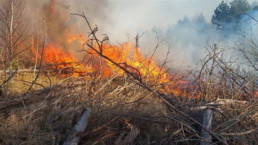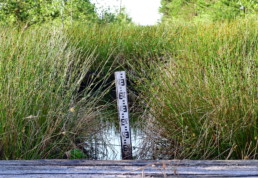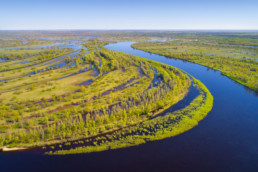Anthropogenic factors limit suitable habitat for wolves in Polesia: new study
The conservation of the Grey wolf (Canis lupus) in Europe has been quite successful, with numbers increasing and the grey carnivore reappearing in many places where it was once completely extirpated. Meanwhile, the Polesian population of wolves is poorly understood, despite its high conservation importance. A new study supported by our project is one of the first attempts to fill this gap and analyse the habitat suitability of wolves in Polesia, taking into account both environmental and, more importantly, anthropogenic factors.
According to official estimates, wolves occur throughout Polesia and their numbers are the highest among the large carnivores of the region. However, the species is only regularly recorded in some protected areas, and overall, the wolves’ densities, distribution and movements in this large region have not yet been systematically studied. Meanwhile, this information is very important for understanding the status of the wolf in Europe as a whole: the Polesian population of the species is of high conservation importance as a link between the wolf population in Russia and those in Poland and the Baltic countries.
The Grey wolf has never disappeared from Polesia. Up to the middle of the 20th century, it used to be widely spread in both Belarus and Ukraine. After the Second World War, however, wolves were regarded as a vermin species threatening the economy and human safety. This entailed systematic overhunting, which, alongside with habitat fragmentation and degradation caused by anthropogenic impact, led to the decline of the wolf population. Still hunted year-round in most of Polesia (in both Ukraine and Belarus), wolves have not disappeared, however, but often find refuge in dense forests and impassable mires.
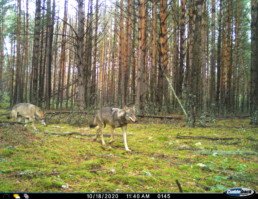
The authors of the study aimed to assess the influence of anthropogenic factors on habitat suitability for wolves and to quantify the extent of their suitable habitat in Polesia. They compiled the wolf presence data collected between 2014 and 2021 from several sources: telemetry data, remote camera-trapping studies, scat samples confirmed by genetic analysis, and geo-referenced wolf records (i.e. photos, remote camera records, and other confirmed observations). To predict suitable habitat, they selected a set of key variables characterizing the landscape, including three related to land cover in the study area (land cover type, tree cover, and Normalized Difference Vegetation Index (NDVI)). Among the variables that reflect the anthropogenic impact, artificial light at night (ALAN), the proportion of cropland, and road density were selected as the most relevant. The wolf presence data were matched to the characteristics of the landscape and then analysed in a 1 km resolution grid.
Data analysis showed that cells with wolf presence differed significantly from those without the species. The animals prefer areas with low ALAN values. The researchers point out that this variable is a better indicator of human presence than census data or the population density index. The proportion of cropland and the density of roads were also lower in the cells with wolves. At the same time, tree cover percentage and NDVI values positively correlated with recorded wolf presence. Additionally, wolf observations were more frequent in cells with forests and wetlands as the dominant habitat type. This could be explained by the abundance of prey and low human disturbance. Alongside similar European studies, the new research confirmed that wolves avoid areas with permanent human presence.
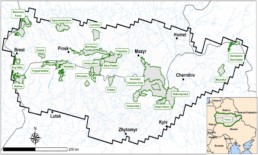
Overall, the proposed model showed that 26% of the territory of Polesia (approximately 42,000 km2) is suitable habitat for the Grey wolf, of which more than 14,300 km2 is highly suitable. The rest of the landscape has low or very low suitability values. At the same time, even suitable habitats are only partially occupied by wolves.
The study showed that core protected areas for wolf conservation in the Polesia region are the Białowieża Forest, the Chornobyl Exclusion Zone with the neighbouring Drevlyanskyi Strict Nature Reserve and the central part of Polesia (Almany Mires Nature Reserve, the Pripyatskyi National Park, the Mid-Pripyat Nature Reserve and the Rivnenskyi Strict Nature Reserve). These protected areas have between 37% and 77% suitable habitat within their boundaries. High-quality unprotected areas suitable for wolves have also been identified. Some of these are isolated but still accessible for wolves.
The authors of the study explain that some high-quality areas are not well connected with other sites. Therefore it is very important to prevent their further fragmentation. The study made it possible to identify the areas that could be taken under protection in order to ensure better connectivity between core protected areas that are crucial for wolf conservation. Thus, this research lays the foundation for the further expansion of the protected area networks as well as for effective, long-term wolf monitoring and management programmes in both Belarus and Ukraine. This variety of measures has the potential to strengthen grey wolf conservation in the region.
Safe and intact: protecting rare and typical habitats in Polesia
19. September 2025
0 Comments7 Minutes
The project “Polesia – Wilderness Without Borders” is part of the Endangered Landscapes & Seascapes Programme and is funded by Arcadia. The project is coordinated by Frankfurt Zoological Society (FZS).



